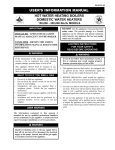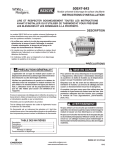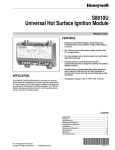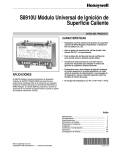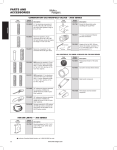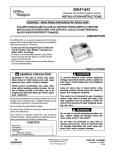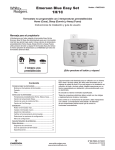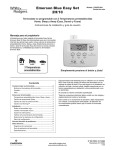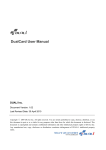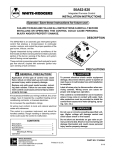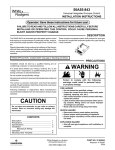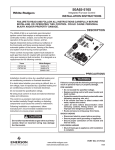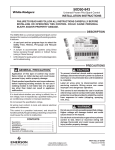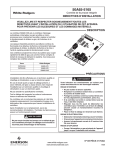Download White Rodgers 50E47-843 Installation Instructions
Transcript
50E47-843 Universal Hot Surface Ignition Control INSTALLATION INSTRUCTIONS FAILURE TO READ AND FOLLOW ALL INSTRUCTIONS CAREFULLY BEFORE INSTALLING OR OPERATING THIS CONTROL COULD CAUSE PERSONAL INJURY AND/OR PROPERTY DAMAGE. DESCRIPTION The 50E47-843 is a universal replacement Hot Surface Ignition (HSI) control designed for maximum compatibility with existing systems. It features: • A card port and six program keys to select the Trial for Ignition Time, Retries, Pre-purge and Igniter Warm Up timings. • A Jumper to accommodate systems using Direct Sense (sensing through ignitor) or Indirect Sense (using a Flame Sensor). • LED indicator for quick system and module diagnostics and troubleshooting. PRECAUTIONS ! GENERAL PRECAUTION ! CAUTION Application of this type of control may cause flame rollout on initial startup and could cause personal injury and/or property damage. To prevent electrical shock and/or equipment damage, disconnect electric power to system at main fuse or circuit breaker box until installation is complete. Check product specification and cross reference before replacing existing module. Do not use if existing module is not listed. Use of a program key other than listed can result in appliance malfunction. Label all wires prior to disconnection when servicing controls. Wiring errors can cause improper and dangerous operation. If in doubt about whether your wiring is millivolt, line, or low voltage, have it inspected by a qualified heating and air conditioning contractor or licensed electrician. This control is not intended for use in locations where it may come in contact with water. Suitable protection must be provided to shield the control from exposure to water (dripping, spraying, rain, etc.). Do not exceed the specification ratings. All wiring must conform to local and national electrical codes and ordinances. This control is a precision instrument, and should be handled carefully. Rough handling or distorting components could cause the control to malfunction. CONTENTS Description .................................................................... 1 Precautions ................................................................... 1 Specifications ................................................................ 2 Installation ..................................................................... 2 Mounting & Wiring Operation & Troubleshooting .......................................... 4 ! WARNING Do not use on circuits exceeding specified voltage. Higher voltage will damage control and could cause shock or fire hazard. Do not short out terminals on gas valve or primary control to test. Short or incorrect wiring will damage thermostat and could cause personal injury and/or property damage. PART NO. 37-6426G www.white-rodgers.com www.emersonclimate.com Replaces 37-6426F 1424 SPECIFICATIONS ELECTRICAL RATINGS: Program Key Timing Specifications Quick Reference Input Voltage: 18 to 30 VAC, 60 Hz Timing and Retry Current: 0.2 amp Relay Contact Ratings: Valve Relay: 1.5 amp @ 25 VAC 60 Hz 0.6 PF Ignitor Relay: 6.0 amp @ 120 VAC 60 Hz- resistive Flame Current Requirements: Minimum current to insure flame detection: 2 µA DC* Maximum current for non-detection: 0.2 µA DC* Maximum allowable leakage resistance: 100 M ohms Program Key (Color) A (blue) B (red) C (green) D (violet) E (orange) F (yellow) Trial for Ignition 4 Sec. 4 Sec. 7 Sec. 7 Sec. 4 Sec. 7 Sec. Retries 0 2 0 2 2 2 Prepurge 30 Sec. 30 Sec. 30 Sec. 30 Sec. 30 Sec. 30 Sec. Interpurge Ignitor (Warmup) 45 Sec. 45 Sec. 45 Sec. 45 Sec. 17 Sec. 17 Sec. NOTE: Program keys are lettered and color coded. * Measured with a DC microammeter in series with the flame probe lead OPERATING TEMPERATURE RANGE: -40° to 175°F (-40° to 80°C) HUMIDITY RANGE: To 95% relative humidity (non-condensing) MOUNTING: Surface mount or 4" x 4" junction box GASES APPROVED: Natural, Manufactured, Mixed, Liquid Petroleum, and LP Gas Air Mixtures. INSTALLATION MOUNTING AND WIRING ! WARNING Do not use on circuits exceeding specified voltage. Higher voltage will damage control and could cause shock or fire hazard. ! CAUTION To prevent electrical shock and/or equipment damage, disconnect electric power to system at main fuse or circuit breaker box until installation is complete. Failure to earth ground the appliance or reversing the neutral and hot wire connection to the line can cause shock hazard. Shut off main gas to heating system until installation is complete. Route and secure all wiring as far from flame as practical to prevent fire and/or equipment damage. 2 NOTE Replace control as unit –no user serviceable parts. All wiring should be installed according to local and national electrical codes and ordinances. The control may be mounted in any orientation on a convenient surface using two #6 x 5/8” sheet metal screws. If desired, control can be mounted on a 4” x 4” junction box using two #8-32 x 5/8” machine screws. The control must be secured to an area that will experience a minimum of vibration and remain below the maximum ambient temperature rating of 175°F. The control is approved for minimum ambient temperatures of -40°F. Refer to the wiring diagrams and wiring table when connecting the control to other components of the system. UL approved 105°C rated 18 gauge minimum wire is recommended for all low voltage connections. UL approved 105°C rated 16 gauge minimum wire is recommended for all line voltage connections. Refer to table below for recommended terminals to mate with those on the control. After installation or replacement, follow appliance manufacturer’s recommended installation/service instructions to insure proper operation. INSTALLATION M V 2 G N D T R T H M V 1 H S 2 L 2 F P H S 1 L 1 M V 2 JUMPER (clip) T R G N D T H M V 1 L 2 H S 2 F P H S 1 L 1 JUMPER FLAME PROBE BURNER GROUND BLUE RED MV GAS VALVE BURNER GROUND ADAPTER MV FLAME PROBE HOT SURFACE IGNITER HOT SURFACE IGNITER MV GAS VALVE MV LIMIT CONTROLLER LIMIT CONTROLLER L1 (HOT) L1 (HOT) L2 THERMOSTAT OR CONTROLLER ALTERNATE LIMIT L2 TRANSFORMER THERMOSTAT OR CONTROLLER Fig. 1 – Typical hookup for White-Rodgers replacement with indirect sense using flame probe M V 2 G N D T R T H M V 1 H S 2 L 2 F P H S 1 L 1 ALTERNATE LIMIT TRANSFORMER Fig. 2 – Typical hookup for competitive replacement with direct flame sense through ignitor JUMPER (clip) Jumper FLAME PROBE BURNER GROUND HOT SURFACE IGNITER MV GAS VALVE MV LIMIT CONTROLLER L1 (HOT) L2 THERMOSTAT OR CONTROLLER ALTERNATE LIMIT Program Keys TRANSFORMER Fig. 4 – Program Key installation/Jumper for models with indirect sense clip jumper Fig. 3 – Typical hookup for competitive replacement with indirect sense using flame probe Terminal Wiring Cross Reference Original Control Terminal Function Burner Ground Connection Transformer Secondary (unswitched leg) Main Valve Common Transformer Secondary (switched leg) Replacement Control Honeywell S89/S890 Terminal Robertshaw HS780 Terminal Old White-Rodgers 50E/F47 Terminal 50E47-843 GND (BURNER) a TR (GND CLIP) b GND GND 24V (GND) a GND TR TR —c MV a (next to TR terminal) MV2 VALVE (GND) a 24V a TH TH TH Main Valve Operator VALVE VALVE d MV d MV1 120 Vac Neutral Leg L2 120V NEUTRAL L2 — L2 e L1 120V HOT L1 Lf L1 120V HOT Power Supply Hot Surface Igniter Element HSI 120V IGN — HS2 Hot Surface Igniter Element HSI 120V IGN IGN g HSI SEN h RS h FP i FP h Power Supply 120 Vac Hot Leg Flame Sensor a Remove quick-connect and replace with the included 1/4" quick-connect. Use green adapter cable (provided) to connect terminal to chassis ground. c Do not use the MV2 terminal. MV2 and TR are interconnected in the appliance wiring. d Remove quick-connect and replace with the included 3/16" quick-connect. e Ground this terminal using green adapter cable if model being replaced does not have 120V neutral power supply connection. f Use the red wire on the included adapter cable. g Use the blue wire on the included adapter cable. h On indirect sense models, remove jumper quick-connect from FP terminal, cut jumper wire at circuit board and discard. On direct sense models, jumper connected to FP terminal, see figure 4. i Remove jumper from FP terminal, cut jumper wire at circuit board and discard. b 3 INSTALLATION INSTALL PROGRAM KEY The control replaces all listed models with the following features: • • • • • • • 120 volt hot surface ignitor remote rod flame sense or direct flame sense through ignitor one or three ignition tries Seven or four second trial for ignition intervals Pre-purge of 30 seconds or less 60 second inter-purge time 17 or 45 second ignitor warm-up times Six program keys are provided for different applications. Timings and Retries for each program key are shown in the Specifications section of this installation manual. Choose the proper program key for the application by using the Module Cross Reference (37-7209). Install the selected program key in the slot on the left side of the module (see figure 4 on page 3). If the module you are replacing is not listed in the Cross Reference, contact the manufacturer of the appliance for a recommended replacement or retrofit. After inserting the proper program key, dispose of the remaining keys to ensure the correct key remains in the module. Reversal of gas valve leads or open connection to MV1 and MV2 may cause control to lockout. See troubleshooting guide for remedy. OPERATION TYPICAL FURNACE INSTALLATION In a typical application the 50E47-843 is designed to energize the ignitor and gas valve and monitor the flame sensor. It is a 100% shut off design that locks out the gas valve if the burner does not light within the trial for ignition period. The ignition sequence begins with a call for heat from the room thermostat. The thermostat applies power to the control. After pre-purge interval, the ignitor warms up for the selected time. The control energizes the gas valve for the selected trial for ignition period. If the burner lights within the allowed period the gas valve will remain open until the call for heat is satisfied. During the trial for ignition period the ignitor is turned off. If the burner does not light, the control will either go into lockout or make two more ignition retries depending on the options selected. The control can be reset from lockout by cycling the thermostat to remove power for a minimum of 3 seconds. It includes a system analysis/troubleshooting LED that indicates normal operation, lockout, weak flame signal or internal control fault. TROUBLESHOOTING For proper control operation, the control must be electrically connected to the gas valve and all the ignitor wiring connectors plugged in. Gas valves with an electric "ON/OFF" switch must have the switch set to "ON". The light on the control provides a self-diagnosis indication. If the red light on the module is on continuously, the fault is likely to be internal to the module. To make sure, interrupt the line or 24 volt thermostat power for a few seconds and then restore. If the internal fault is indicated again, and flame sensor is not shorted to ground, replace the control. A flash- Three visual checks 1. The ignitor will warm up and glow red 2. The main burner flame will ignite 3. The main burner flame will continue to burn after the ignitor is turned off Troubleshooting the system consists of checking for these three visual indications. The chart on the next page defines the proper action if any of these indications do not occur. LED Condition Green Solid On Green Rapid Flashing Red Rapid Flash Normal Red 1 Flash Red 2 Flash Yellow Solid On Yellow Rapid Flashing OFF Red Solid On 4 ing light indicates the problem is most likely in the external components or wiring (see chart below). Proceed as follows: Weak flame signal Control in lockout Flame sensed when there should be none Control in lockout Ignition retries exceeded Control in lockout Ignition recycles exceeded Internal self check Improper Polarity Internal Failure Gas valve miswired or Internal error detected TROUBLESHOOTING Call for heat, Thermostat contacts close Does YellowLEDlightfor approximately 2 seconds? (Module Self Check) no yes Does YellowLEDFlash? yes no DoesRedLEDFlashorremain lit? Measure AC voltage between terminalL1andTH. If voltage is approximately 145 VAC, polarity is reversed; reverse secondary leads on control transformer. Correct reading should be approximately 95 VAC. yes Reset control to clear lockout and confirm fault. Rapid Flash = Flame Sensed when no flame should be present. 1 Flash = Number of Retries exceeded, control locked out. 2 Flashes = Recycles Exceeded, control locked out. RedLightcontinuousindicateseitheraninternal fault or miswired gas valve. CheckwiresatMV1andMV2for proper connection or swap wires to correct fault. If fault persists, replace module. no CheckLow Voltage to module (TH-TR). CheckLimitSwitches Checkvent pressure switch (if used). yes Indicates a poor flame sense signal. Checkfor short in Flame Sensor wiring, Poor Furnace or BurnerGround,Shorting flame sensor, flame sensor wiring, or dirty flame probe. Clean flame probe. no Confirm 120 Volts to ignitor terminals(HS1andL2on module) If voltage is present replace ignitor. no Checkgassupplyandpressuretovalve. Checkfor 24 volt output on module (terminals MV1 and MV2). If no voltage replace module. If gas valve is receiving voltage but not opening replace valve. no DoesGreenLEDLight? CheckLow Voltage to module (TH-TR). If no voltage: CheckLimitSwitches Checkvent pressure switch (if used). yes DoesGreenLEDFlash? no Afterprepurgedoesignitor glow red? yes Does the main burner light? yes Does system run until call for heat ends? Yes Normal Operation no Checklimitswitches. Checksensorleadandgroundfor continuity. Checkinsulatorofflamesensororignitorfor excessive temperature. Temperature above 1000 deg F. can ground flame sense. 5 White-Rodgers is a business of Emerson Electric Co. The Emerson logo is a trademark and service mark of Emerson Electric Co. www.white-rodgers.com www.emersonclimate.com SOLUCIÓN DE PROBLEMAS Llamadadecalor,los contactos del termostato se cierran ¿ElLEDamarillopermanece encendido aproximadamente 2 segundos?(autoverificacióndel módulo) no sí ¿ElLEDamarilloesintermitente? sí no ¿ElLEDrojoesintermitenteo permaneceencendido? sí no ¿ElLEDverdeesintermitente? no Verifiquesielvoltajealmóduloesbajo(TH-TR).Sinohayvoltaje: Verifiquelosinterruptoreslimitadores Verifiqueelinterruptordepresióndeventeo(siseutiliza). MidaelvoltajeCAentrelaterminalL1yTH.Sielvoltajeesde aproximadamente 145 VCA, la polaridad esta invertida; invierta los cablesdelsecundariodeltransformadordecontrol.Lalectura correctadeberíaserdeaproximadamente95VCA. Reseteeelcontrolparadesbloquearloyconfirmarlafalla. Intermitente rápido = se detecta llama cuando no debería haber una llama presente. 1intermitente=seexcediólacantidaddereintentos,elcontrolestábloqueado. 2intermitentes=seexcediólacantidaddeciclosdeapagado/ encendido,elcontrolestábloqueado. Laluzrojacontinuaindicaunafallainternaounaválvuladegas malconectada.VerifiquequeloscablesenMV1yMV2esténbien conectados o intercambie los cables para solucionar la falla. Si la falla persiste, cambie el módulo. Verifiquesielvoltajealmóduloesbajo(TH-TR). Verifiquelosinterruptoreslimitadores Verifiqueelinterruptordepresióndeventeo(siseutiliza). sí ¿ElLEDverdeparpadea? sí no Despuésdelpre-purgado, ¿el dispositivo de encendido seenciendedecolorrojo? no Indicaunaseñaldedeteccióndellamadébil.Verifiquequenohaya un cortocircuito en las conexiones del detector de llama, una mala conexiónatierradelacalderaodelquemador,undetectorde llama en cortocircuito, las conexiones del detector de llama o una sondadellamasucia.Limpielasondadelallama. Verifiquequehaya120voltiosenlasterminalesdeldispositivode encendido(HS1yL2delmódulo).Sihayvoltajepresente,cambie el dispositivo de encendido. sí ¿Elquemadorprincipalse enciende? no Verifiqueelsuministrodegasylapresiónalaválvula. Verifiquelasalidade24voltiosenelmódulo(terminalesMV1yMV2). Si no hay voltaje, cambie el módulo. Silaválvuladegasestárecibiendovoltajeperonoseabre, cambie la válvula. sí ¿Elsistemafuncionahastaque terminalallamadadecalor? no Verifiquelosinterruptoreslimitadores. Verifiquelacontinuidaddelcabledeldetectorylatierra. Verifiquequelatemperaturadelaisladordeldetectordellamao deldispositivodeencendidonoseaexcesiva.Lastemperaturas superiores a los 1000 °F pueden conectar a tierra el detector de llama. Sí Funcionamiento normal White-Rodgers es una negocio de Emerson Electric Co. El logotipo de Emerson es una marca comercial y una marca de servicio de Emerson Electric Co. www.white-rodgers.com www.emersonclimate.com Para el funcionamiento adecuado del control, éste debe estar eléctricamente conectado a la válvula de gas y todos los conectores de los cables del dispositivo de encendido deben estar enchufados. Las válvulas de gas con un interruptor eléctrico de APAGADO/ ENCENDIDO deben tener el interruptor colocado en la posición ENCENDIDO. La luz del control proporciona una indicación de autodiagnóstico. Si la luz roja del módulo está permanentemente encendida, es probable que se trate de una falla interna del módulo. Para asegurarse, interrumpa la alimentación de línea o la alimen-tación de 24 voltios al termostato durante algunos segundos y luego vuelva a conectarla. Si vuelve a indicar una falla interna y el detector de llama no está en cortocircuito con tierra, cambie el control. Una SOLUCIÓN DE PROBLEMAS luz intermitente indica que es muy probable que el problema se encuentre en los componentes externos o en las conexiones (vea el siguiente cuadro). Proceda como se indica a continuación: Tres verificaciones visuales 1) El dispositivo de encendido se calienta y se ilumina de color rojo 2) La llama del quemador principal se enciende 3) La llama del quemador principal continua ardiendo después de apagar el dispositivo de encendido La solución de problemas del sistema consiste en verificar estas tres indicaciones visuales. El cuadro de la siguiente página indica cómo proceder si no se produce ninguna de estas indicaciones. La válvula de gas está mal conectada o se detectó un error interno Roja fijo Falla interna APAGADO Polaridad inadecuada Amarilla intermitente rápido Autoverificación interna Amarilla fijo Control bloqueado Se excedió la cantidad de ciclos de apagado/ encendido Roja 2 intermitentes Control bloqueado Se excedió la cantidad de reintentos de encendido Roja 1 intermitente El control está bloqueado Se detectó una llama cuando en realidad no debería haber ninguna Roja intermitente rápido Señal de llama débil Verde intermitente rápido Normal Verde fijo Estado LED 5 INSTALACIÓN INSTALE LA TECLA DE PROGRAMA El control reemplaza todos los modelos incluidos en la lista con las siguientes características: • Dispositivo de encendido de superficie caliente de 120 voltios • Detección de llama con varilla remota o detección de llama directa a través del dispositivo de encendido • Uno o tres intentos de encendido • Intervalos de prueba de encendido de siete o cuatro segundos • Pre-purgado de 30 segundos o menos • Tiempo entre purgados de 60 segundos • Tiempos de calentamiento del dispositivo de encendido de 17 ó 45 segundos Se suministran seis teclas de programa para diferentes aplicaciones. Los tiempos y el número de reintentos para cada tecla de programa se indican en la sección Especificaciones de este manual de instalación. Elija la tecla de programa adecuada para la aplicación usando la Referencia cruzada para módulos de White-Rodgers (37-7209). Instale la tecla de programa seleccionada en la ranura del lado izquierdo del módulo (vea la figura 4 en la página 3). Si el módulo que desea cambiar no está incluido en las tablas de módulos de White-Rodgers o de la competencia, póngase en contacto con el fabricante del equipo para consultar por un repuesto o reacondicionamiento recomendado. Después de insertar la tecla de programa adecuada, deseche las teclas restantes para asegurarse de que quede la tecla correcta en el módulo. La inversión de los cables de la válvula de gas o una conexión abierta a MV1 y MV2 pueden hacer que el control se bloquee. Vea cómo proceder en la guía de solución de problemas. FUNCIONAMIENTO INSTALACIÓN TÍPICA DE LA CALDERA En una aplicación típica el 50E47-843 está diseñado para energizar el dispositivo de encendido y la válvula de gas y monitorear el detector de llama. Es un diseño con cierre 100% que bloquea la válvula de gas si el quemador no se enciende dentro del período de prueba de encendido. La secuencia de encendido comienza con una llamada de calor del termostato de la habitación. El termostato aplica alimentación al control. Después del intervalo pre-purgado, el dispositivo de encendido se calienta durante el tiempo seleccionado. El control energiza la válvula de gas durante el período de prueba de encendido seleccionado. Si el quemador se enciende dentro del período permitido, la válvula de gas permanecerá abierta hasta que se satisfaga la llamada de calor. Durante el período de prueba de encendido, el dispositivo de encendido se apaga. Si el quemador no se enciende, el control se bloqueará o realizará dos intentos más de encendido según las opciones seleccionadas. El control puede desbloquearse encendiendo y apagando el termostato para desconectar la alimentación durante un mínimo de 3 segundos. Incluye un LED de análisis del sistema/solución de problemas que indica funcionamiento normal, bloqueo, señal de llama débil o falla del control interno. 4 VÁLVULA DE GAS M V 2 T R G N D T H M V 1 L 2 H S 2 F P L 1 TIERRA DEL QUEMADOR H S 1 ADAPTADOR T R G N D T H LÍMITE ALTERNO M V 1 L 2 PUENTE (corte) M V 2 T R G N D T H M V 1 L 2 H S 2 DISPOSITIVO DE ENCENDIDO DE SUPERFICIE CALIENTE VÁLVULA DE GAS F P INSTALACIÓN H S 1 PUENTE CONTROLADOR DE LÍMITE L1 (VIVO) L1 (VIVO) TERMOSTATO O CONTROLADOR H S 1 L 1 L 1 DISPOSITIVO DE ENCENDIDO DE SUPERFICIE CALIENTE MV MV CONTROLADOR DE LÍMITE L2 L2 TRANSFORMADOR H S 2 F P SONDA DE LLAMA TIERRA DEL QUEMADOR AZUL ROJO MV MV SONDA DE LLAMA TERMOSTATO O CONTROLADOR LÍMITE ALTERNO TRANSFORMADOR Fig. 2 – Conexión típica para el repuesto de la competencia con detección de llama directa a través del dispositivo de encendido Fig. 1 – Conexión típica para el repuesto de White-Rodgers con detección indirecta usando una sonda de llama M V 2 Puente PUENTE (corte) SONDA DE LLAMA TIERRA DEL QUEMADOR VÁLVULA DE GAS DISPOSITIVO DE ENCENDIDO DE SUPERFICIE CALIENTE MV MV CONTROLADOR DE LÍMITE L1 (VIVO) Teclasdeprograma L2 TERMOSTATO O CONTROLADOR LÍMITE ALTERNO TRANSFORMADOR Fig. 4 – Instalación de la tecla del programa/puente para modelos de detección indirecta Corte el puente Fig. 3 – Conexión típica para el repuesto de la competencia con detección de llama indirecta a través de una sonda de llama Referencia cruzada de conexiones de las terminales Control original Terminal Terminal Terminal White-Rodgers Función de la terminal Honeywell S89/S890 Robertshaw HS780 50E/F47 anterior Conexión a tierra del quemador GND (QUEMADOR)a TR (CLIP DE TIERRA) b GND Secundario del transformador 24V (GND) a GND TR (pata no conmutada) Común de válvula principal VÁLVULA (GND) a— c MV a (junto a la terminal TR) Secundario del transformador 24V a TH TH (pata conmutada) Operador de válvula principal VÁLVULA VÁLVULA d MV d Pata neutra de 120 Vca L2 120 V NEUTRO L2 — Alimentación Pata vivo 120 Vca L1 120V VIVO L1 L f Alimentación Elemento dispositivo de HSI 120V IGN — encendido de superficie caliente Elemento dispositivo de HSI 120V IGN IGN g encendido de superficie caliente Detector de llama SEN hRS h FP i Control de repuesto 50E47-843 GND TR MV2 TH MV1 L2 e L1 120V VIVO HS2 HSI FP h a Retire la conexión rápida y cámbiela por la conexión rápida de 1/4 pulg. suministrada. b Utilice el cable adaptador verde (suministrado) para conectar la terminal a la tierra del chasis. c No utilice la terminal MV2. MV2 y TR están interconectadas en las conexiones del equipo. d Retire la conexión rápida y cámbiela por la conexión rápida de 3/16 pulg. suministrada. e Conecte a tierra esta terminal usando el cable adaptador verde si el modelo que va a cambiar no tiene una conexión de alimentación neutra de 120 V. f Utilice el cable rojo en el cable adaptador suministrado. g Utilice el cable azul en el cable adaptador suministrado. h En los modelos de detección indirecta, retire la conexión rápida del puente de la terminal FP, corte el cable puente en el tablero de circuitos y deséchelo. En los modelos de detección directa, con el puente conectado a la terminal FP, vea la figura 4. i Retire el puente de la terminal FP, corte el cable del puente en el tablero de circuitos y deséchelo. 3 ESPECIFICACIONES CARACTERÍSTICAS ELÉCTRICAS: Voltaje de entrada: 18 a 30 VCA, 60 Hz Corriente: 0.2 amp Especificaciones de tiempos de las teclas de programa Referencia rápida Tiempos y reintentos NOTA: las teclas de programa están identificadas con letras y colores. * Medida con un microamperímetro de CC en serie con el electrodo de sonda de llama TECLA DE PRUEBA PROGRAMA DE RE PRE- (COLOR) ENCENDIDO INTENTOS PURGADO A (azul) 4 Seg. 0 30 Seg. B (roja) 4 Seg. 2 30 Seg. C (verde) 7 Seg. 0 30 Seg. D (violeta) 7 Seg. 2 30 Seg. E (anaranjada) 4 Seg. 2 30 Seg. F (amarilla) 7 Seg. 2 30 Seg. Requisitos de corriente de llama: Corriente mínima para asegurar la detección de la llama: 2 µA CC* Corriente máxima para la no detección: 0.2 µA CC* Resistencia a fugas máxima permitida: 100 M ohmios Características de contacto de los relés: Relé de válvula: 1.5 amp a 25 VCA 60 Hz 0.6 PF Relé del dispositivo de encendido: 6.0 amp a 120 VCA 60 Hz- resistivo CALENTAR DISPOSITIVO ENCENDIDO 45 Seg. 45 Seg. 45 Seg. 45 Seg. 17 Seg. 17 Seg. RANGO DE TEMPERATURA OPERATIVA: -40° a 175°F (-40° a 80°C) RANGO DE HUMEDAD: Hasta 95% de humedad relativa (sin condensación) SOPORTE: Soporte de superficie o caja de conexiones de 4 pulg. x 4 pulg. GASES APROBADOS: natural, fabricado, mixto, gas licuado de petróleo y mezclas de aire y gas licuado de petróleo. INSTALACIÓN MONTAJE Y CONEXIONES ! ¡ADVERTENCIA! No utilizar en circuitos que excedan el voltaje especificado ya que los voltajes más altos dañarán el control y pueden causar riesgos de electrocución o incendio. ! ¡PRECAUCIÓN! Para evitar descargas eléctricas y/o daños al equipo, desconecte la alimentación eléctrica en la caja de fusibles o disyuntores principal hasta que haya finalizado la instalación del sistema. Si no se conecta a tierra el equipo o se invierte la conexión del cable neutro y el vivo a la línea pueden producirse riesgos de descarga eléctrica. Cierre la alimentación de gas principal al sistema de calefacción hasta haber terminado la instalación. Pase y fije todos los cables lo más lejos posible de la llama para evitar incendios y/o daños al equipo. NOTA Cambie el control entero en caso de ser necesario. No contiene piezas que puedan ser reparadas por el usuario. Todas las conexiones deben instalarse conforme a los códigos y reglamentaciones locales y nacionales. El control puede montarse con cualquier orientación sobre una superficie conveniente usando dos tornillos autorroscantes calibre 6 x 5/8 pulg. Si lo desea, el control puede montarse sobre una caja de conexiones de 4 pulg. x 4 pulg. usando dos tornillos mecánicos calibre 8-32 x 5/8 pulg. El control debe fijarse en un lugar que esté sujeto a un mínimo de vibraciones y que se mantenga por debajo de la temperatura ambiente nominal de 175°F. El control está aprobado para temperaturas ambientes mínimas de -40°F. Refiérase a los diagramas y a la tabla de conexiones para conectar el control a otros componentes del sistema. Para todas las conexiones de bajo voltaje se recomienda utilizar cables calibre 18 como mínimo aptos para 105°C y aprobados por las normas UL. Para todas las conexiones de voltaje de línea se recomienda utilizar cables calibre 16 como mínimo aptos para 105°C y aprobados por las normas UL. Consulte la siguiente tabla para la combinación de terminales recomendada para el control. Una vez finalizada la instalación o el reemplazo, siga las instrucciones de instalación/mantenimiento recomendadas por el fabricante del equipo para asegurar su correcto funcionamiento. 2 50E47-843 Control de encendido de superficie caliente universal INSTRUCCIONES DE INSTALACIÓN EL NO LEER Y SEGUIR CON CUIDADO TODAS LAS INSTRUCCIONES ANTES DE INSTALAR O UTILIZAR ESTE CONTROL, PODRÍA CAUSAR LESIONES PERSONALES Y/O DAÑOS MATERIALES. DESCRIPCIÓN El 50E47-843 es un control de encendido de superficie caliente de repuesto diseñado para ofrecer la máxima compatibilidad con los sistemas existentes. Este control incluye: • Un puerto de tarjeta y seis teclas de programa para seleccionar los tiempos de prueba de encendido, rein tentos, pre-purgado y calentamiento del dispositivo de encendido. • Un puente para adaptar el control a sistemas que utilizan detección directa (detección a través del dispositivo de en cendido) o detección indirecta (usando un detector de llama). • Indicador de LED para facilitar el diagnóstico y solución de fallas en el sistema y el módulo. PRECAUCIONES ! ¡PRECAUCIÓN GENERAL! La aplicación de este tipo de control podría causar llamaradas al poner en marcha el equipo y producir lesiones personales y/o daños materiales. Verifique las especificaciones del producto y las referencias cruzadas antes de cambiar el módulo existente. No lo utilice si el módulo existente no está incluido en la lista. El uso de una tecla de programa que no esté incluida en la lista puede producir el mal funcionamiento del equipo. Si tiene dudas acerca de si su conexión eléctrica es milivoltio, de línea o de bajo voltaje, hágala inspeccionar por un técnico especializado en equipos de calefacción y aire acondicionado o por un electricista autorizado. ! ¡PRECAUCIÓN! Para evitar descargas eléctricas y/o daños al equipo, desconecte la alimentación eléctrica en la caja de fusibles o disyuntores principal hasta que haya finalizado la instalación del sistema. Identifique todos los cables antes de desconectarlos cuando realice tareas de mantenimiento en los controles. Los errores en las conexiones pueden dar lugar al funcionamiento incorrecto y peligroso del dispositivo. Este control no está diseñado para ser utilizado en lugares en los que puede entrar en contacto con agua. Debe proporcionarse una protección adecuada para proteger el control de su exposición al agua (goteo, rociado, lluvia, etc.). No exceda los valores nominales especificados. Todas las conexiones deben cumplir con los códigos y reglamentaciones locales y nacionales. Este control es un instrumento de precisión y debe manipularse con cuidado. La manipulación descuidada o la distorsión de los componentes podrían hacer que el control no funcionara correctamente. CONTENIDO Descripción ............................................................................. 1 Precauciones .......................................................................... 1 Especificaciones ..................................................................... 2 Instalación .............................................................................. 2 Montaje y Conexiones Funcionamiento y Solución de problemas ............................... 4 ! ¡ADVERTENCIA! No utilizar en circuitos que excedan el voltaje especificado ya que los voltajes más altos dañarán el control y pueden causar riesgos de electrocución o incendio. No cortocircuite las terminales de la válvula de gas ni del control principal para probarlos. Un cortocircuito o una conexión incorrecta dañará el termostato y podría causar lesiones personales y/o daños materiales. N° DE PIEZA 37-6426G www.white-rodgers.com www.emersonclimate.com Reemplaza 37-6426F 1424
This document in other languages
- español: White Rodgers 50E47-843












